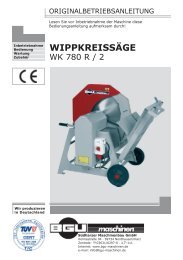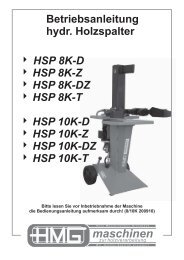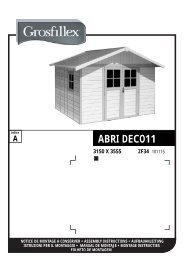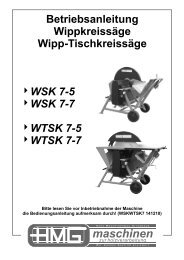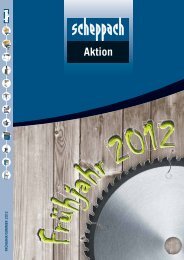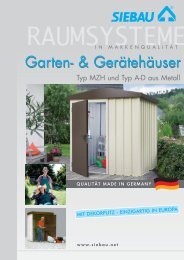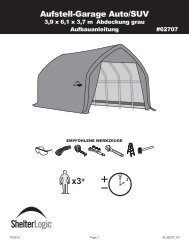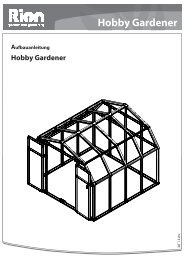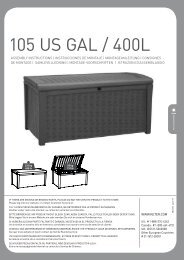Notice d'utilisation - Atika
Notice d'utilisation - Atika
Notice d'utilisation - Atika
You also want an ePaper? Increase the reach of your titles
YUMPU automatically turns print PDFs into web optimized ePapers that Google loves.
• Wear suitable work clothes:<br />
− Do not wear loose-fitting clothes or jewellery; they can<br />
catch in moving parts.<br />
− slip-proof shoes<br />
− Hairnet in case of long hair<br />
• Wear protective clothing:<br />
− ear protection (Sound intensity level at workplace can<br />
exceed 85 dB (A))<br />
− safety goggles<br />
− Dust mask with work activities generating dust<br />
− Gloves for blade exchange.<br />
• Keep your workplace in an orderly condition! Untidiness<br />
can result in accidents.<br />
• Take into consideration environmental influences:<br />
− Do not expose this surface planing and thicknessing<br />
machine to rain.<br />
− Do not use the equipment in a damp or wet environment.<br />
− Do only work with sufficient visibility conditions. Provide<br />
for good illumination.<br />
− Do not use this machine near inflammable liquids or<br />
gases.<br />
− The wood dust generated during operation impedes the<br />
necessary view and is harmful to health to some<br />
degree. Connect this machine to a dust or shavings<br />
extractor (e.g. small portable deduster).<br />
• Never leave the machine unattended.<br />
• Persons under the age of 18 must not operate the device.<br />
• Keep other persons away.<br />
Do not allow other persons, especially children, to touch<br />
the tool or cable.<br />
Keep them away from your working area.<br />
• Do not overload the machine! You work better and safer in<br />
the given performance range.<br />
• Only operate the machine with complete and correctly<br />
attached safety equipment and do not alter anything on the<br />
machine that could impair the safety.<br />
• Assume the correct work posture. Stand to the side of the<br />
machine.<br />
• While the machine runs keep your hands at a safe distance<br />
from the blade shaft and the location where shavings are<br />
ejected.<br />
• Always keep sufficient distance to the blade shaft. Maintain<br />
sufficient distance from driven components during operation.<br />
• Remove all nails and metallic objects from the work piece<br />
before planing or thicknessing.<br />
• Pay attention that the work piece does not contain any<br />
cables, ropes, cords or the like.<br />
• Do not machine wood which has numerous knots and knot<br />
holes.<br />
• Only start planing and thicknessing when the blade shaft has<br />
reached its required speed.<br />
• Use only well sharpened blades as edgeless blades<br />
increase not only the risk of backstrokes but also charge<br />
the motor.<br />
• Use appropriate devices when machining thin work pieces to<br />
position and guide the wood pieces properly.<br />
• When machining make sure that the unused blade shaft is<br />
covered by the knife guard.<br />
• Do only use tools according to EN 847-1 which are marked<br />
with MAN.<br />
The use of other tools and other accessories can<br />
signify a risk of injury for you.<br />
• Use pushing blocks or bars when machining short work<br />
pieces.<br />
• Do not use defective pushing blocks or bars<br />
• Always keep the pushing blocks and bars handy at the<br />
machine if they are not used.<br />
• Secure long workpieces against dropping down when<br />
finishing the cutting process. Use roller supports or similar<br />
devices for this purpose.<br />
• Do not remove splinters, shavings and waste with your<br />
hands from the dangerous area of the blade shaft.<br />
• Switch the machine off and remove the mains plug from<br />
the socket when<br />
− carrying out repair works<br />
− maintenance and cleaning<br />
− Fault elimination (this also includes removing of jammed<br />
shavings or splinters)<br />
− checks of connecting lines, whether these are knotted or<br />
damaged<br />
− Transporting the machine<br />
− Changing the blades<br />
− leaving the machine unattended (even during short<br />
interruptions)<br />
• Maintain your machine with care:<br />
− Keep your tools sharp and clean in order to be able to<br />
work better and safer.<br />
− Follow the maintenance instructions and the<br />
instructions for tool exchange.<br />
− Keep handles dry and free of oil and grease.<br />
• Check the machine for possible damage:<br />
− Before further use of the machine the protection<br />
devices or slightly damaged parts must be checked<br />
carefully for their proper and intended function.<br />
− Check whether the movable parts function perfectly and<br />
do not stick or whether the parts are damaged. All parts<br />
must be correctly installed and fulfil all conditions to<br />
ensure perfect operation of the machine.<br />
− Damaged guards and parts must be properly repaired or<br />
exchanged by a recognized, specialist workshop; insofar<br />
as nothing else is stated in the instructions for use.<br />
− Damaged or illegible safety labels should be replaced<br />
immediately.<br />
• Do not allow any tool key to be plugged in!<br />
Before switching on, check always that wrenches and<br />
adjusting tools are removed.<br />
• Store unused equipment in a dry, locked place out of the<br />
reach of children.<br />
18



